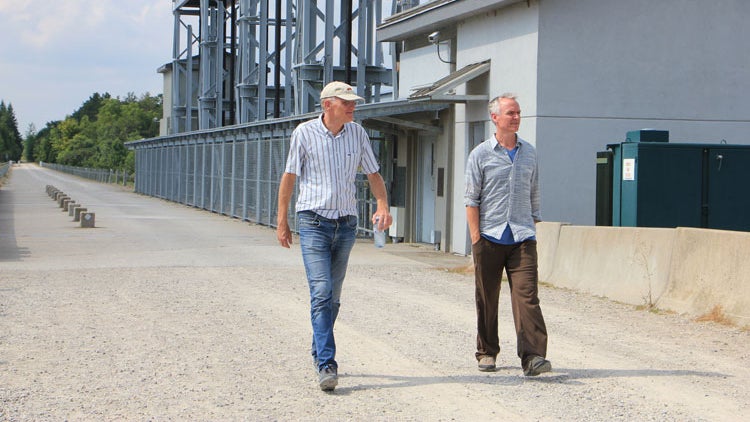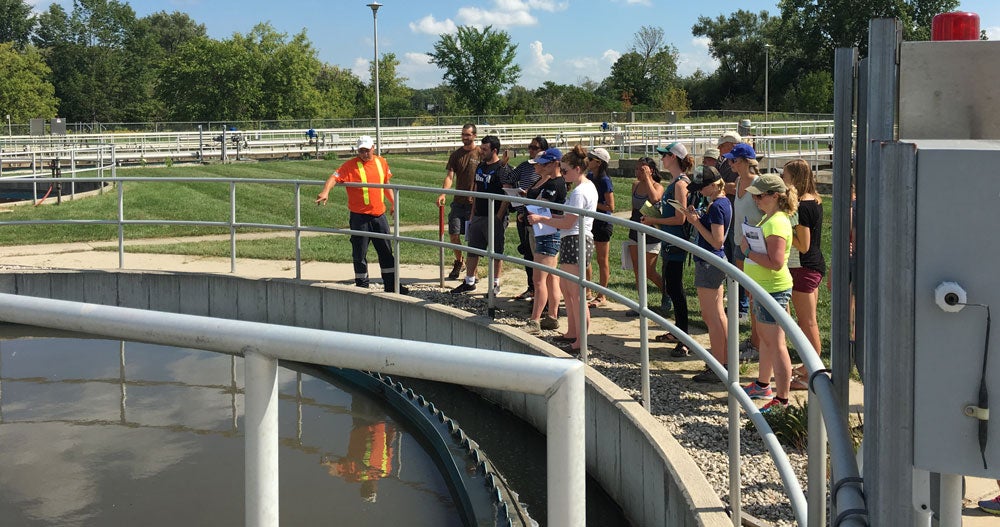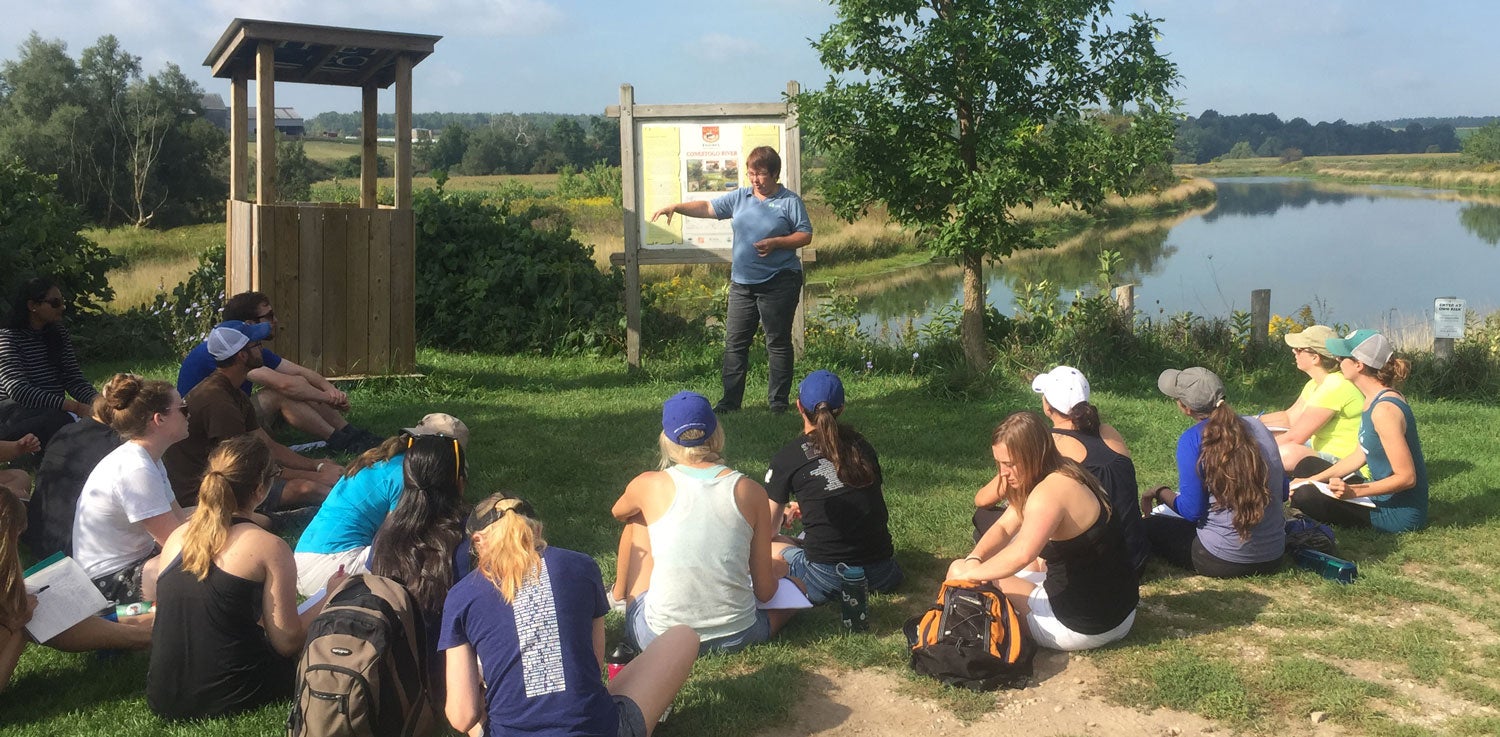
Pieter van der Zaag (pictured above left on the Shand Dam at Belwood Lake with program director Bruce MacVicar) spent a week with University of Waterloo Collaborative Water Program students during his stay as an RBC Visiting Fellow.
Story by Pieter van der Zaag, professor of integrated water resources management at the UNESCO-IHE Institute for Water Education in Delft and professor at Delft University of Technology
From Sept. 6-12 nearly 50 graduate students from the University of Waterloo embarked on what I call the Grand River Safari1. This is a unique group of students who come from different backgrounds, disciplines and cultures. They study the same watershed, listening to a variety of stakeholders and other experts, discussing the problems and challenges of the watershed, identifying underlying drivers and causes of environmental change and critically assessing possible avenues of action. This watershed journey is very capably coordinated and led by Mark Servos and Simon Courtenay, with the assistance of Maricor Arlos and Sondra Eger.
Being an RBC Visiting Fellow to the Water Institute, this Dutchman was privileged to participate in this Safari, allowing me to get to know Waterloo staff and students, and also to get acquainted with a river that I didn’t know. I can now add the Grand River to my list of favourite watersheds.
Over time the Grand watershed has witnessed massive changes, particularly with respect to land use, the use of its water resources and the construction of hydraulic works. This has led to major modifications of the river flow regime and water quality. Temperature of the river water during summer is a “hot” item, in particular for fishers and the trout themselves. I never realised that cold water is a resource to be treasured! Colder water is older water, stemming from groundwater, so any action that increases infiltration of rainfall water and boosts base flows is good for trout. As nearly always is the case, slowing the flow adds value.
Some stories stuck. The legacy of the production of Agent Orange in Elmira on local groundwater bodies and seepage flows into the river made a deep impression. How much has our value system changed over the last two generations on either side of the ocean! In The Netherlands we used to view the river Rhine as an efficient sewer not more than 50 years ago.

Students learn about local water treatment techniques at Elmira Wastewater Treatment Plant. Photo: Igor Markelov.
Farmers are the keepers of the land and thus very important stakeholders in the watershed. As land owners they directly feel the consequences of any new policy that regulates the watershed. Yet farmers come in different shapes: from smallholder dairy farmers using traditional technologies to the most advanced vegetable and ginseng producers.
I was particularly impressed by the staff of the Grand River Conservation Authority (GRCA), not only their professionalism and dedication, but in particular the manner in which they engage with farmers. Whereas they might have formal authority, they prefer to earn it through taking the interests of farmers seriously, jointly exploring ways to improve land use practices that decrease harmful effects on the river and tailor any intervention to the specific characteristics of each farmer. GRCA staff clearly prefer to nudge, and use the carrot rather than the stick. The same holds for how they deal with municipalities that need to decrease spills of untreated wastewater. “Leading from behind”, they call it.
This strategy resonates with the Dutch strategy of “polderen” — a verb that is derived from the iconic Dutch “polder” watershed, a piece of land that was formerly a lake or part of the sea and now drained and enclosed by dikes and “reclaimed”. Polderen means to seek consensus among stakeholders if there is an issue to be resolved, rather than top-down enforcement — as if we are all shareholders in a dike: we all have to cooperate else the dike will fail and we all suffer.

Anne Loeffler, of the Grand River Conservation Authority, shares how she works with Mennonite farmers to improve water quality. Photo: Maricor Arlos.
The Grand River Safari wouldn’t have been complete without the First Nation’s water ceremony, which was a moving event. It impressed me, and I think all others taking part in it, that we form integral part of the watershed, sojourning for a while in this beautiful space that we borrow from the generations to come.
The water flowing through the watershed connects these different facets, issues and people. Journeying through it is therefore an apt didactical method to promote interdisciplinarity in academia. Well done, Waterloo! I look forward to the research findings that will emanate from this great group of future water leaders!
[1] My use of the Swahili word “safari” (journey) is inspired by a chapter written on another river (Incomati) in a different continent (Africa), by the then minister of water of South Africa, Dr Kader Asmal [“Arid African upstream safari: A transboundary expedition to seek and share new sources of water.” Chapter 3 in: J. Dooge, J. Delli Priscoli, M.R. Llamas (eds.), 2004. Water and Ethics. UNESCO, Paris].